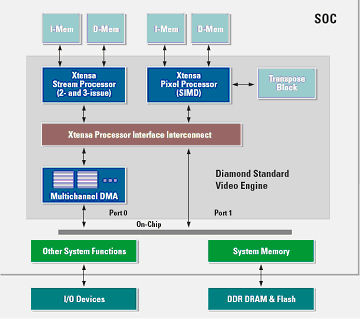Tensilica is now offering a high-performance licensable video engine capable of MPEG-4 ASP encoding at D1 resolution. The processor is called the Diamond 388VDO, and it’s one of four new dual-core “VDO” video engines from Tensilica. The 388VDO is the highest-performance member of the quartet and supports a variety of video codec standards at resolutions up to D1 (i.e., standard definition television). Target applications include chips for mobile handsets and personal media players.
In its early days, Tensilica focused on offering a processor core that was intended to be configured by licensees using Tensilica’s specialized tools. As system and chip designs have become more complex and development timelines have become more compressed, however, many SoC designers have gravitated towards larger building blocks and away from lower-level design details—such as configuring processors.
Tensilica wisely responded by creating a range of pre-configured, application-oriented “Diamond Standard” cores, which include the new VDO processors. The company also partnered with Ittiam to develop multiple video codecs, and expects about 70% of its 388VDO customers to buy its off-the-shelf codecs and use the processor as a black box. (Ittiam also provides codecs for TI’s DaVinci video SoCs.)
This combination of hardware plus software has moved Tensilica up the food chain, a strategy that seems to appeal to Tensilica’s customers. The company still supports the “roll your own” approach, but estimates that about 30-40% of its customers now choose one of its standard cores. According to Tensilica, many of these customers later opt to create customized cores for enhanced performance.
The 388VDO incorporates two heterogeneous processor cores, each of which is configured to support different types of processing. One core supports 16- and 8-way SIMD operations and is optimized for the highly data-parallel processing that’s characteristic of tasks like motion compensation and transforms; this core is called the “pixel processor.” The other is optimized for the sequential processing needed for decision-making and bitstream unpacking; this core is called the “stream processor.” A block diagram of a 388VDO-based SoC is shown in Figure 1.

Figure 1. Block diagram of Diamond 388VDO-based SoC (graphic courtesy of Tensilica)
Tensilica customized both cores with specialized hardware and instructions to accelerate common video codecs; for example, the 388VDO supports custom instructions for accelerating the computationally demanding CABAC entropy decoding algorithm used in H.264..
Tensilica’s use of heterogeneous processor cores is sensible. High-end video requires a mixture of parallelizable and sequential processing capabilities, and using two different cores enables a more efficient mapping between tasks and processors. The cores’ programmability is an advantage in video applications, which often need to support multiple existing or emerging standards, and may require custom processing. Usually, the heterogeneous processor approach has a downside—software engineers have to learn two instruction sets and two tool chains. Tensilica doesn’t have this problem since both cores use the same tool chain and basic instruction set. Furthermore, since Tensilica is offering off-the-shelf codecs and expects relatively few of its 388VDO customers to write their own code, the development tools may play a less central role..
According to Tensilica, the 388VDO consumes roughly 11 mm^2 in a TSMC 130G process and 6.6 mm^2 in 90G (these figures are post-layout and include memory). The company says that a 200 MHz 388VDO can run the following codecs at D1 resolution (720 x 480 @ 30 fps for NTSC; 720 x 576 @ 25 fps for PAL):.
- H.264 main profile @ L3 (decode)
- MPEG-4 ASP (no GMC) @ L5 (decode)
- MPEG-2 MP @ ML (decode)
- WMV9/VC1 main profile (decode)
- MPEG-4 ASP (encode)
Competitors to the 388VDO include licensable cores from ARC (a company that, like Tensilica, offers configurable cores) and Ceva, both of whom offer video-oriented multi-core processing engines. A less widely known potential competitor is Silicon Hive, which offers licensable, programmable, massively parallel architectures for video. The 388VDO will also compete with hardwired (non-programmable) video codec solutions, such as those from Hantro (recently acquired by On2).


Add new comment